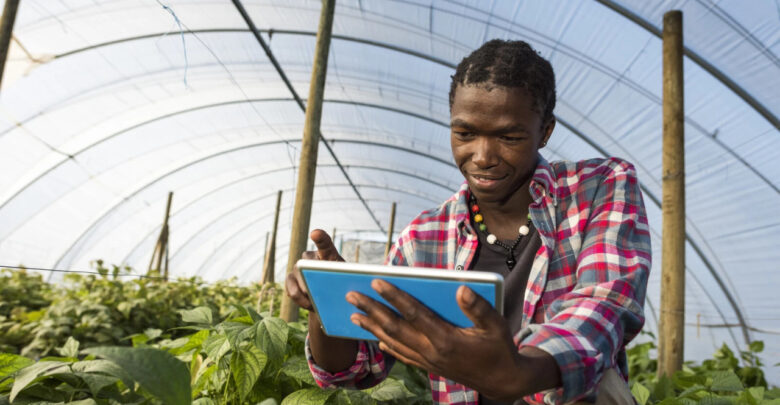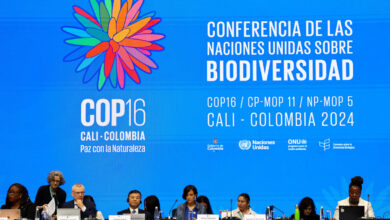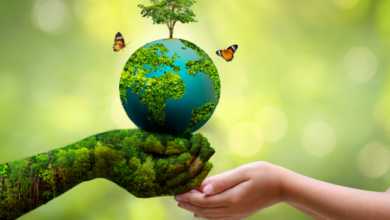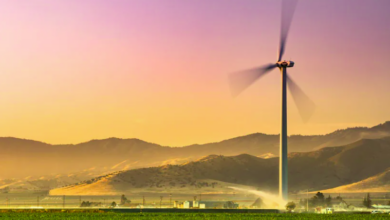Environnement
Can Artificial Intelligence Mitigate and Help Adapt to Climate Change Impacts on Agriculture ?

Agriculture is one of the sectors most vulnerable to the growing impacts of climate change. Rising temperatures, shifting precipitation patterns, more frequent extreme weather events, and prolonged droughts [1] are altering the productivity of crops and livestock, particularly in regions already facing water scarcity and food insecurity. These disruptions threaten global food supply chains, posing risks to food security and rural livelihoods.
As the challenges facing agriculture intensify, innovative technologies, particularly Artificial Intelligence (AI), have emerged as promising tools to enhance both mitigation and adaptation strategies. AI offers solutions by improving farming practices, optimizing resource use, and helping farmers build resilience to climate variability. By integrating AI technologies into agricultural systems, stakeholders can not only reduce the sector’s carbon footprint but also protect and enhance productivity in the face of changing environmental conditions [2].
This article explores the various ways climate change is impacting agriculture and examines how AI can be employed to mitigate and adapt to these challenges, contributing to sustainable food security.
Climate Change Impacts on Agriculture:
Climate change has profound and complex impacts on agriculture, affecting both crop production and livestock systems. These impacts vary by region and can be both direct, such as changes in temperature and precipitation
patterns, and indirect, such as shifts in pest populations, soil degradation, and increased vulnerability to extreme weather events [3].
Higher temperatures caused by climate change [1] can reduce yields of crops like wheat, rice, and maize, particularly in tropical and subtropical regions. Heat stress can negatively affect photosynthesis and plant development.
Warmer climates can lengthen growing seasons in some regions, allowing multiple harvests, but in others, excessive heat may reduce growing periods or push crops beyond their thermal tolerance limits.
More frequent and severe droughts reduce soil moisture, water availability for irrigation, and overall agricultural productivity, especially in arid and semi-arid regions [4].
The Role of Artificial Intelligence in Mitigating and Adapting to Climate Change Impacts on Agriculture
Artificial Intelligence (AI) offers transformative solutions for both mitigating and adapting to climate change by leveraging its capabilities in data analysis, modeling, and optimization [5, 6].
❖ Mitigation of Climate Change in Agriculture:
AI helps reduce the agricultural sector’s contribution to climate change through smarter resource use and improving the efficiency of farming practices.
AI-powered precision farming techniques analyze data from sensors, satellite images, and drones to optimize water use, fertilizer application, and pesticide distribution. By applying inputs only where and when needed, farmers can reduce waste, cut emissions from fertilizer overuse, and increase yields. This also reduces greenhouse gas (GHG) emissions related to over-application of agrochemicals [7].
AI tools monitor soil health in real-time by analyzing data on moisture, nutrient levels, and temperature. Predictive models help farmers adjust irrigation schedules, reducing water use and preventing soil degradation. Sustainable soil management reduces the release of carbon stored in the soil, contributing to climate mitigation [8].
AI systems optimize livestock feed, health monitoring, and breeding to reduce methane emissions from cattle and other livestock. By enhancing productivity and minimizing resource use, AI reduces the carbon footprint of animal farming [9].
AI models can recommend crop varieties that are more resilient to climate change, such as drought-resistant or heat-tolerant crops, helping farmers to adapt to changing environmental conditions. This reduces the need for GHG-intensive irrigation or chemical interventions [10].
Adaptation to Climate Change in Agriculture:
AI-driven technologies provide adaptive solutions to help farmers manage risks from climate change, improving resilience and productivity in agriculture.
AI-based weather forecasting models predict climate-related events like droughts, floods, and heatwaves with greater accuracy. Farmers can use these forecasts to adjust planting and harvesting schedules, protect crops, and mitigate potential losses from extreme weather conditions.AI systems monitor environmental data to detect drought onset or excessive rainfall. Predictive models provide guidance on water usage and irrigation, helping farmers optimize water resources in water-scarce regions, especially those vulnerable to climate change impacts.
AI helps in designing crop rotation schedules, planting techniques, and irrigation strategies that make farms more resilient to climate variability. Farmers can adapt to changing growing seasons and temperatures by adjusting planting times and crop management techniques based on AI recommendations.
AI can analyze satellite imagery and data from sensors to detect early signs of pest infestations or plant diseases. This allows for early interventions, preventing widespread crop damage and reducing the need for harmful pesticides, which contribute to GHG emissions.
Drawing Inspiration from International Champions: How Artificial Intelligence and Mathematics Can Revolutionize Food Security in Morocco and Africa
To address food insecurity in Morocco and Africa, we can draw inspiration from the successes of teams that have won medals in international artificial intelligence and mathematics competitions. These teams have demonstrated that innovation and collaboration can lead to effective solutions for complex problems [12].
Conclusion
The impacts of climate change on agriculture are profound, threatening the stability of global food systems and rural livelihoods. However, Artificial Intelligence presents an opportunity to mitigate these effects and adapt to evolving climate conditions. Through precision farming, optimized resource management, early warning systems for extreme weather, and climate-resilient agricultural practices, AI can help transform agriculture into a more sustainable and resilient sector.
By adopting AI-driven solutions, farmers can reduce greenhouse gas emissions, minimize resource waste, and increase productivity, even in the face of climate uncertainty. As agriculture continues to confront the escalating challenges of climate change, integrating AI into the sector will be crucial for safeguarding food security, supporting rural communities, and ensuring a sustainable future for generations to come.
References
[1] Bouramdane, A.-A (2022). Assessment of CMIP6 Multi-Model Projections Worldwide: Which Regions Are Getting Warmer and Are Going through a Drought in Africa and Morocco? What Changes from CMIP5 to CMIP6? Sustainability, 15, 690. https://doi.org/10.3390/su15010690
[2] Mana, A., Allouhi, A., Hamrani, A., Rahman, S., el Jamaoui, I., & Jayachandran, K. (2024). Sustainable AI-Based Production Agriculture: Exploring AI Applications and Implications in Agricultural Practices. Smart Agricultural Technology.
[3] Habib-ur-Rahman, M., Ahmad, A., Raza, A., Hasnain, M.U., Alharby, H.F., Alzahrani, Y.M., Bamagoos, A.A., Hakeem, K.R., Ahmad, S., Nasim, W., Ali, S., Mansour, F., & El Sabagh, A. (2022). Impact of climate change on agricultural production; Issues, challenges, and opportunities in Asia. Frontiers in Plant Science, 13.
[4] Akter, N., & Rafiqul Islam, M. (2017). Heat stress effects and management in wheat. A review. Agronomy for Sustainable Development, 37, 1-17.
[5] Alazzai, W.K., Obaid, M.K., Abood, B.S., & Alzubaidi, L. (2024). Smart Agriculture Solutions: Harnessing AI and IoT for Crop Management. E3S Web of Conferences.
[6]. Big Data, Artificial Intelligence, and Data Analytics in Climate Change Research. Advances in Geographical and Environmental Sciences.
[7] Son, N., Chen, C., & Syu, C. (2024). Towards Artificial Intelligence Applications in Precision and Sustainable Agriculture. Agronomy.
[8] Deorankar, P.A., Rohankar, A.A., & Scholar, P. (2020). Soil Health Monitoring System using AI. Journal of emerging technologies and innovative research.
[9] Akintan, O., Gebremedhin, K.G., & Uyeh, D.D. (2024). Animal Feed Formulation—Connecting Technologies to Build a Resilient and Sustainable System. Animals : an Open Access Journal from MDPI, 14.
[10] Pixley, K.V., Cairns, J.E., Lopez-Ridaura, S., Ojiewo, C.O., Dawud, M.A., Drabo, I., Mindaye, T.T., Nebié, B., Asea, G., Das, B., Daudi, H., Desmae, H., Batieno, B.J., Boukar, O., Mukankusi, C.T., Nkalubo, S.T., Hearne, S.J., Dhugga, K.S., Gandhi, H., Snapp, S., & Zepeda-Villarreal, E.A. (2023). Redesigning crop varieties to win the race between climate change and food security. Molecular plant.
[11] Fenz, S., Neubauer, T., Friedel, J.K., & Wohlmuth, M. (2023). AI- and data-driven crop rotation planning. Comput. Electron. Agric., 212, 108160.
[12] Le Parisien. (2024, 25 juillet). Deux intelligences artificielles de Google remportent une médaille aux Olympiades de mathématiques.
https://www.leparisien.fr/high-tech/deux-intelligences-artificielles-de-google-remportent-une-medaille-aux-olympiades-de-mathematiques-25-07-2024-6CVQ6KOTLNBBJHDLC4NELVYAKU.php
By Ayat-Allah Bouramdane
Assistant Professor – Researcher at the International University of Rabat (College of E&A – LERMA lab).






